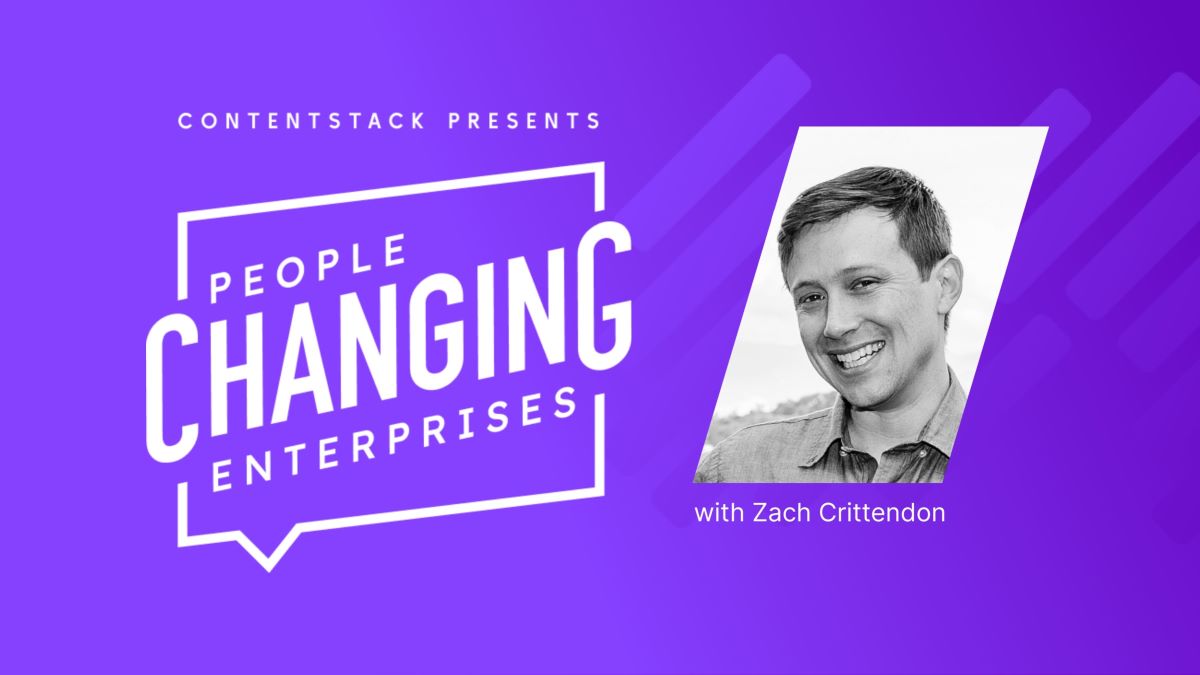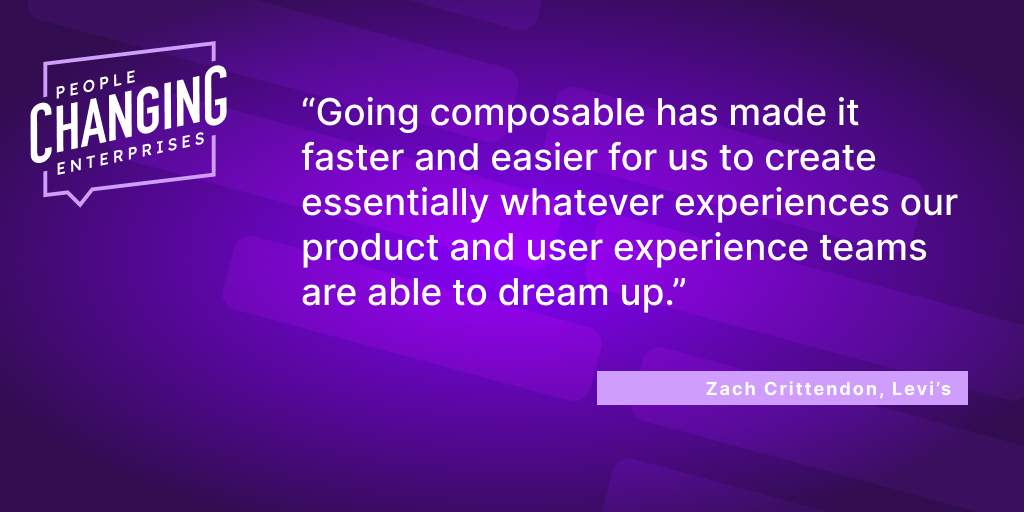Levi's Zach Crittendon supports big ambitions with flexible tech

One thing jeans and technology have in common? You can outgrow them. As digital became increasingly critical to Levi Strauss and Co.’s strategy, it was clear that the single, monolithic platform that had been powering the website wasn’t going to be able to keep up with the company’s omnichannel ambitions.
“That was a great way to get started,” said Zach Crittendon, software architect at Levi Strauss & Co., about their legacy all-in-one platform. “It has a lot of best practices built into it and was sufficient to get us live on the internet, but it was not going to scale with us in all of the things that we needed to do as a company.”
Crittendon recently spoke with us about developing scalable solutions, designing tools that empower creative teams and the advice he has for other leaders making the transition to a composable architecture.
Minimize risk with phases
Moving from an all-in-one platform to a composable approach, where different systems handle different responsibilities, can be a complex challenge — especially as most companies aim to make this transition in a way that quickly proves value and poses minimal risk.
“A huge part of the transition is finding the business case that fits it,” Crittendon said. “One that will give you a real world evaluation of what you’ve built, what its strengths and weaknesses are, but in a way that doesn’t jeopardize your main line of business.”
For Levi’s, this meant taking a phased approach. In phase one, the team added a headless CMS to create a new homepage while the rest of the website stayed in the legacy platform. Phase two was to completely replace the legacy platform for the Eastern European website, which was a simpler use case because a third party handled a large part of the order management process. In phase three, the team completely moved to a composable architecture.
These phases allowed the team to gradually add complexity and step off the monolith one capability at a time instead of a big-bang replatform effort.
“You can have those learnings and if there are any issues you have the time to work through and identify and resolve those before you bet the business on it,” Crittendon said.
Build with growth in mind
“The most important thing with composable is having a very clear idea of where you’re going," Crittendon said. “Make sure that you have a good idea of what a strong, powerful, flexible, composable architecture looks like in the future.”
Keeping the long-term vision in mind helped the Levi’s team to develop and implement capabilities that would be able to grow with the business. For example, instead of creating a one-off template, the homepage was built in a modular way with the intention that the APIs, content types, content schema and the content itself could later be reused and repurposed for different use cases.
“We ensured that the initial architecture was structured in such a way that we could expand the number of locations that this modular system could be used within our site and that the set of modules themselves could be expanded,” Crittendon said.
Having a foundation of reusable, flexible modules allows the team to repurpose content, integrate data, combine experience elements and deliver to different channels with very little technical investment. For instance, in a two-day hackathon they were able to develop shoppable videos that display inventory-aware products and local prices.
“It’s very simple to reuse all of these pieces that we’ve built and just reconfigure them to suit the requirements that we have at the moment,” Crittendon said.
Enable creative teams
The long-term vision that guides how capabilities are designed and implemented should be developed with both technology and creative teams at the table. At Levi’s, the long-held desire from the marketing team to be able to blend brand-driven content with conversation-driven experience was a major factor in the design of the new architecture.
“Going composable has made it faster and easier for us to create essentially whatever experiences our product and user experience teams are able to dream up,” Crittendon said.

“The way we’ve integrated our commerce and product information management APIs with our CMS APIs, we’re able to make it very easy for our business users to create these experiences that combine the commerce and the content in one place,” he explained.
Crittendon and his team have approached this from two directions. First, by making it easy to put “content in commerce” and letting business users put text, images and videos directly in category pages and product grids. Second, by enabling “commerce in content” experiences like the ability to tag editorial photos with related products and use real-time data from the commerce platform to only show products that are available.
“We’re not trapped in the template of a product display page but can instead deliver a very rich, custom, bespoke brand experience and have the commerce part of that experience just a click away,” Crittendon said. “That’s something that our team had been dreaming of for years before we moved to this composable architecture.”
Focus on usability
“Half the project is the experience that we’re delivering to the external customers, the other half of the project is how we’re doing that in a way that is easy to use and easy to learn and understand for the business users,” Crittendon said.
“As a technology person my job, as I see it, is to understand what it is that they’re trying to convey and what the differences and similarities are across campaigns, locales and languages,” Crittendon said, explaining that a critical part of designing a solution for a global, multi-brand organization like Levi’s is making sure there is significant flexibility. So while architecture components are designed to be reused as much as possible, it’s easy to adjust if a country or brand needs to do something slightly different.
This approach has made it possible for Levi’s, in just a few years, to go from a website with basic e-commerce functionality to having over 100 business users actively contributing to an omnichannel experience with thousands of pages live across 60 countries and nine languages.
“Being able to create the tools that allow that to be managed at scale by a really wide group of users is something that I’m really proud of” Crittendon said. “Business users are able to create really rich experiences without any ongoing, day-to-day involvement from quality assurance, engineering, or performance.”
Learn more about going composable here.
About Contentstack
The Contentstack team comprises highly skilled professionals specializing in product marketing, customer acquisition and retention, and digital marketing strategy. With extensive experience holding senior positions at renowned technology companies across Fortune 500, mid-size, and start-up sectors, our team offers impactful solutions based on diverse backgrounds and extensive industry knowledge.
Contentstack is on a mission to deliver the world’s best digital experiences through a fusion of cutting-edge content management, customer data, personalization, and AI technology. Iconic brands, such as AirFrance KLM, ASICS, Burberry, Mattel, Mitsubishi, and Walmart, depend on the platform to rise above the noise in today's crowded digital markets and gain their competitive edge.
In January 2025, Contentstack proudly secured its first-ever position as a Visionary in the 2025 Gartner® Magic Quadrant™ for Digital Experience Platforms (DXP). Further solidifying its prominent standing, Contentstack was recognized as a Leader in the Forrester Research, Inc. March 2025 report, “The Forrester Wave™: Content Management Systems (CMS), Q1 2025.” Contentstack was the only pure headless provider named as a Leader in the report, which evaluated 13 top CMS providers on 19 criteria for current offering and strategy.
Follow Contentstack on LinkedIn.





